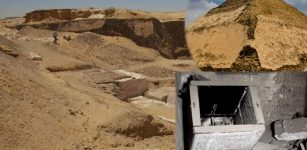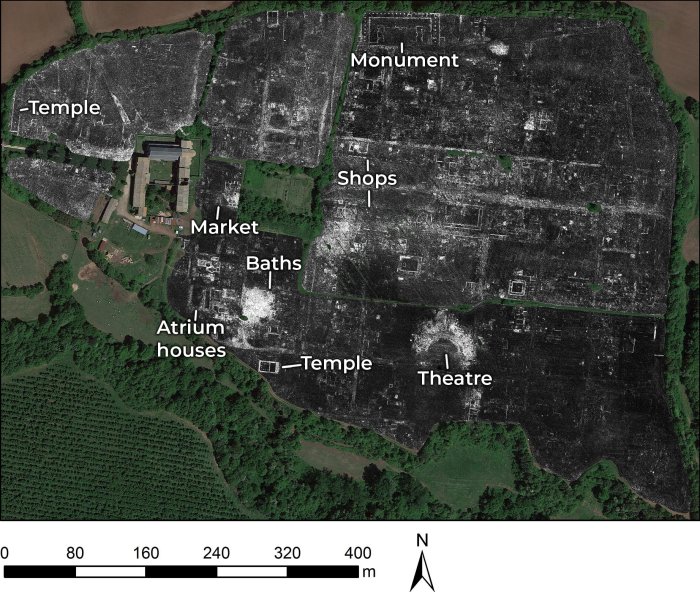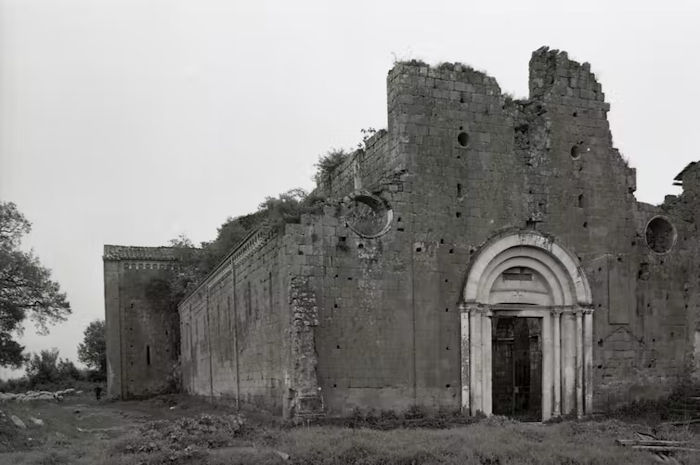Falerii Novi – Huge Ancient Underground Roman City Reveals Its Secrets
Ellen Lloyd - AncientPages.com - The ancient Roman Empire relied on a network of cities that played a pivotal role in its domain's administration, social organization, and economy. By the first century A.D., there were approximately 2000 cities across the Roman world, including Falerii Novi.
Ancient ruins of the city of Falerii Novi. Credit: Adobe Stock - Buffy1982
Historical records inform that Falerii Novi was founded by the Falisci tribe in 241 B.C., following the defeat of a revolt led by the inhabitants of nearby Falerii Veteres (now Civita Castellana). The fortified city of Falerii Novi in Lazio, Italy, was inhabited until the 7th century B.C., when it was abandoned and, more or less forgotten, lying buried beneath agricultural fields and olive groves.
"According to one source, 12th-century chronicler Zonaras, Rome forcibly resettled the defeated Faliscans to a less defensible location — Falerii Novi or "new Falerii." Its construction, intimately associated with the Roman road Via Amerina, is a rare example of preserved Roman Republican urban planning.
The city was occupied through Roman Antiquity and the early medieval period (6th and 7th centuries C.E.). It was on a strategic trading route leading north from Rome, perhaps from Ponte Milvio, through central Italy.
We know little of its later history, except that the still-standing church of Santa Maria di Falleri was founded by Benedictines in 1036, disbanded in 1392, and the building was in ruins by 1571. It is now restored mainly with excavated Roman roads visible beneath the floor.
Credit: Verdonck et al., Antiquity
When and how Falerii Novi became buried remains a mystery. How did such a large walled city become covered in so much soil? And what happened in late Antiquity to cause its abandonment?" 1
In 2020, archeologists from the University of Cambridge and Ghent announced a detailed ground-penetrating radar mapping survey that found a vast ancient underground city.
The Roman city discovered using radar was unlike anything seen before. Covering an area of approximately 30 hectares and being just under half the size of Pompeii, the town consisted of a bath complex, market, temple, public monument, and a sprawling network of water pipes.
The ancient city discovered by the researchers was Falerii Novi, but the site needed to be much more significant to be excavated. Fortunately, high-resolution 3D images of buried structures allowed scientists to travel back in time and better understand what this place once looked like.
Credit: Verdonck et al., Antiquity
The GPS survey revealed "previously unrecorded public buildings, such as a temple, a macellum or market building, and a bath complex. While these buildings fall within the expected repertoire of a Roman city, some are architecturally sophisticated—more elaborate than would usually be expected in a small town. More unexpected were two enormous structures adjacent to the walls. Immediately east of the north gate is an enclosure defined on three sides by a substantial portions duplex (covered passageway with a central row of columns) approximately 90 × 40m in size, opening onto the street. A pair of structures, each with a central niche, face each other within the interior of the complex." 2
In their science study, the researchers explained they were unfamiliar with a direct parallel to this structure, but it was a public monument.
According to the scientists, one of the most incredible structures discovered during this survey was, without doubt, a colossal structure over 100 meters long, thought to be a colonnaded temple against the north city wall.
The church of Santa Maria di Falleri in 1972. Credit: Wikimedia Commons
The discovery of the ancient underground city of Falerii Novi is significant because understanding the earliest development of towns in Italy during this period is central to any comprehension of Roman imperialism itself. However, as Professor Martin Millett also explained," the earliest phases of these cities, many of which have continued in occupation until today, lie deeply buried beneath later structures." 3
The discovery of the ancient underground city of Falerii Novi emphasizes the importance of a ground-penetrating radar mapping survey in archaeology.
Written by Ellen Lloyd – AncientPages.com
Updated on January 2024
Copyright © AncientPages.com All rights reserved. This material may not be published, broadcast, rewritten or redistributed in whole or part without the express written permission of AncientPages.com
Expand for references- Emlyn Dodd - Unearthing Falerii Novi’s secrets in the hot Italian summer: an archaeologist reports from the dig, The Conversation
- Verdonck, L., Launaro, A., Vermeulen, F., & Millett, M. (2020). Ground-penetrating radar survey at Falerii Novi: A new approach to the study of Roman cities. Antiquity, 94(375), 705-723. doi:10.15184/aqy.2020.82
- Conny Waters - Amazing Underground Ancient Roman City Discovered In Italy - AncientPages.com
More From Ancient Pages
-
 Mysterious Inca Citadel With Platforms, Passages And Walls Discovered In Peru’s Rainforest
Archaeology | Oct 15, 2017
Mysterious Inca Citadel With Platforms, Passages And Walls Discovered In Peru’s Rainforest
Archaeology | Oct 15, 2017 -
 U.S. Bible Museum Says Five Dead Sea Scrolls Fragments In Their Collection Are Fake
Archaeology | Oct 25, 2018
U.S. Bible Museum Says Five Dead Sea Scrolls Fragments In Their Collection Are Fake
Archaeology | Oct 25, 2018 -
 Researchers Sequenced 137 Human Genomes From The Middle East
Archaeology | Aug 6, 2021
Researchers Sequenced 137 Human Genomes From The Middle East
Archaeology | Aug 6, 2021 -
 Joseph Pujol – The Professional Farter Who Entertained People
Featured Stories | Jan 29, 2020
Joseph Pujol – The Professional Farter Who Entertained People
Featured Stories | Jan 29, 2020 -
 Magnificent St. Paul’s Catacombs – Largest Underground Roman Cemetery In Malta
Featured Stories | Aug 28, 2019
Magnificent St. Paul’s Catacombs – Largest Underground Roman Cemetery In Malta
Featured Stories | Aug 28, 2019 -
 Remarkable Neanderthal Flute Found In Divje Babe Cave Is The World’s Oldest Musical Instrument
Artifacts | Dec 11, 2023
Remarkable Neanderthal Flute Found In Divje Babe Cave Is The World’s Oldest Musical Instrument
Artifacts | Dec 11, 2023 -
 European-Made Sealed Bottles Of Cherries Dated To 18th Century Found At Washington’s Mount Vernon
Archaeology | Apr 23, 2024
European-Made Sealed Bottles Of Cherries Dated To 18th Century Found At Washington’s Mount Vernon
Archaeology | Apr 23, 2024 -
 Earliest Ochre Crayon Used By Our Ancestors 10,000 Years Ago Found In Yorkshire, Northern England
Archaeology | Jan 29, 2018
Earliest Ochre Crayon Used By Our Ancestors 10,000 Years Ago Found In Yorkshire, Northern England
Archaeology | Jan 29, 2018 -
 Cyrus The Great: Founder Of Achaemenid Empire Who Conquered Medians, Lydians And Babylonians
Featured Stories | Mar 21, 2019
Cyrus The Great: Founder Of Achaemenid Empire Who Conquered Medians, Lydians And Babylonians
Featured Stories | Mar 21, 2019 -
 Nearly 2,000-Year-Old Aqueduct Discovered Near Ancient Monastery Khor Virap In Armenia
Archaeology | Jan 29, 2020
Nearly 2,000-Year-Old Aqueduct Discovered Near Ancient Monastery Khor Virap In Armenia
Archaeology | Jan 29, 2020 -
 Mireuksa Pagoda: Largest And One Of The Oldest Of Korean Pagodas
Archaeology | Jan 1, 2016
Mireuksa Pagoda: Largest And One Of The Oldest Of Korean Pagodas
Archaeology | Jan 1, 2016 -
 Cooking, Roasting And Eating Of Root Plants Is 120,000-Year-Old Habit
Archaeology | Jun 7, 2019
Cooking, Roasting And Eating Of Root Plants Is 120,000-Year-Old Habit
Archaeology | Jun 7, 2019 -
 Ptolemaic Granite Sarcophagus Found In Alexandria, Egypt
Archaeology | Jul 6, 2018
Ptolemaic Granite Sarcophagus Found In Alexandria, Egypt
Archaeology | Jul 6, 2018 -
 More Than 1,000 Prehistoric Burial Mounds Discovered In The Netherlands
Archaeology | Jan 26, 2023
More Than 1,000 Prehistoric Burial Mounds Discovered In The Netherlands
Archaeology | Jan 26, 2023 -
 Medieval Warhorses Were Pony-Sized And Much Smaller Than Previously Thought
Archaeology | Jan 11, 2022
Medieval Warhorses Were Pony-Sized And Much Smaller Than Previously Thought
Archaeology | Jan 11, 2022 -
 Independent Invention: Iconic Native American Stone Tool Technology Discovered In Arabia
Archaeology | Aug 6, 2020
Independent Invention: Iconic Native American Stone Tool Technology Discovered In Arabia
Archaeology | Aug 6, 2020 -
 Identity Of Anti-Christ And Number 666 Revealed By Ancient History Professor
Archaeology | Apr 6, 2019
Identity Of Anti-Christ And Number 666 Revealed By Ancient History Professor
Archaeology | Apr 6, 2019 -
 Focus On Turkana Boy: Modern Human Body Evolved More Recently Than Once Believed
Archaeology | Jul 8, 2020
Focus On Turkana Boy: Modern Human Body Evolved More Recently Than Once Believed
Archaeology | Jul 8, 2020 -
 Mystery Of The Unbreached Burial Chamber Inside A Little-Known Pyramid In The Dashur Complex
Featured Stories | Mar 18, 2022
Mystery Of The Unbreached Burial Chamber Inside A Little-Known Pyramid In The Dashur Complex
Featured Stories | Mar 18, 2022 -
 Underwater Drone Images Reveal Oldest Human-Made Structure In The Baltic Sea
Archaeology | Feb 13, 2024
Underwater Drone Images Reveal Oldest Human-Made Structure In The Baltic Sea
Archaeology | Feb 13, 2024




